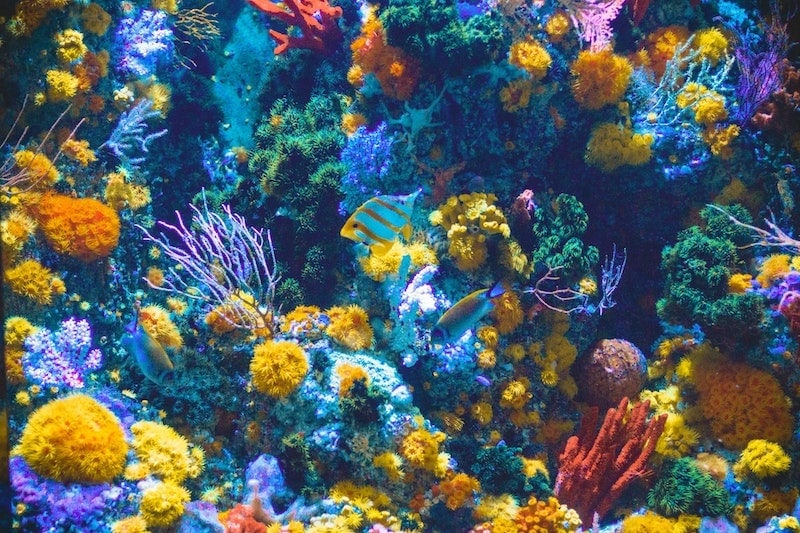10 Types of Freshwater Eels For Your Home Aquarium: Pictures & Facts

Updated on

If you want to get an aquarium, or already have one, but want to step things up a bit and not get just normal old fish, you might consider getting a freshwater aquarium eel or two. While eels tend to have a bad rep, they can actually make for pretty decent pets, although usually quite hard to care for.
Today we want to talk about 10 different types of freshwater aquarium eels, their basic characteristics, and how to take care of them. We will also be going over some other questions and recommendations that have to do with keeping freshwater aquarium eels at home.
The 10 Freshwater Aquarium Eels
There are technically 10 different freshwater eels that can be kept in a home aquarium. For the most part, eels like a certain level of salt in their water, but the 10 we are going to discuss below can live in 100% freshwater. Keep in mind that eels can be aggressive, they can get very large, need lots of space, and are definitely not ideal for beginner aquarium owners.
Let’s go over the most common and popular types of eels and how to take care of them.
1. Tire Track Eel

The tire track eel is quite a large eel and can grow to 30 inches or 75 cm in length. Therefore, they require a very large tank of 125 gallons at the least. Tire track eels can be kept in pairs, but beware that each of these eels will require 125 gallons, so you will need a huge tank if you want to keep more than one.
The tire track eel likes to bury itself in a soft substrate, so they require good aquarium sand. Moreover, these are skittish animals and require a lot of safe hiding spaces. Lots of aquarium plants, rocks, caves, pieces of driftwood, and PVC piping are recommended. At first, the tire track eel will be very cautious and skittish and probably won’t swim around much, but they will quickly become comfortable when properly cared for.
When it comes to conditions, the temperature needs to be between 73 and 82 degrees Fahrenheit, with a pH level between 6.5 and 8, and a water hardness level between 5 and 15 dGH. The tire track eel is fairly aggressive and will eat whatever smaller fish it can fit in its mouth. It is recommended to add a small amount of salt to the water as it will help improve their immunity against various parasites and diseases.
Tire track eels require strong water movement, great water filtration, and a high level of water oxygenation.
2. Zig Zag Eel
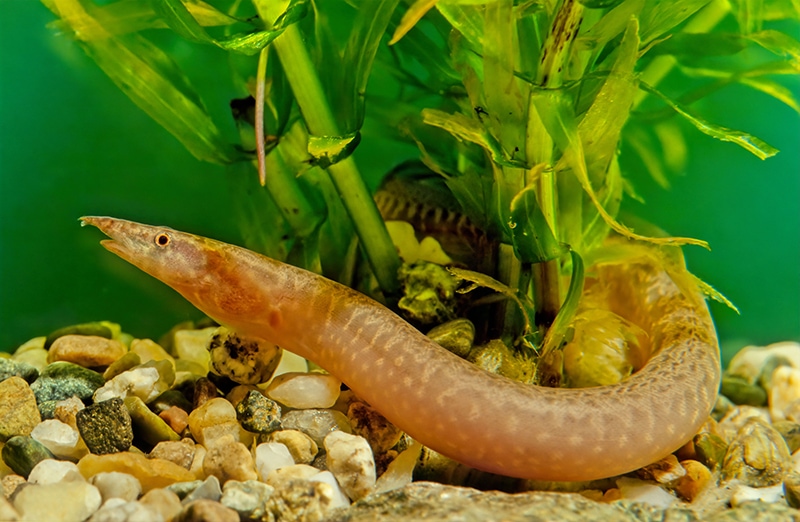
The zig-zag eel can grow up to 36 inches or 90 cm in length, but this is usually in the wild. In captivity, they will usually max out at around 24 inches or 60 cm. However, they do still require a very large tank either way. Each zig-zag eel requires an aquarium of at least 150 gallons, so you better have a whole lot of space in your home. Keep in mind that these eels can live up to 20 years, so it is quite a commitment. You can keep them with smaller fish, but anything small enough to be eaten will be eaten.
These eels are very active and carnivorous predators that enjoy hunting during the night. They should have very fine gravel or sand as substrate, as they do like to burrow in it. The zig-zag eel is fairly aggressive and territorial, so keeping it with other bottom dwellers should be avoided. Moreover, you will want to provide them with plenty of plants, rocks, caves, and things like PVC pipes for hiding spots and privacy, anything which helps create a territory for them.
The zig-zag eel requires the water to be between 73 and 82 degrees Fahrenheit, with a pH level between 6.5 and 8, with a water hardness level between 5 and 15 dGH.
A very strong filter that creates a fair amount of water movement is definitely recommended here, and something to help oxygenate the water too.
3. Fire Eel

The fire eel is one of the larger eels that you can keep at home. These guys can grow up to 40 inches or 100 cm in length, so they are big no doubt. For a fully grown adult fire eel, you will need a fish tank of at least 180 gallons, as they need a whole lot of room. They may not grow as large in an aquarium as in the wild, but they still get quite large.
This is a fairly good community tank fish, as it will just ignore most fish that are not perceived as sources of food. That said, anything smaller than it can fit in its mouth will get eaten. It is not recommended to keep these guys with other bottom dwellers. These eels like to bury themselves in a fine gravel substrate, and you should have at least 2.5 inches of substrate.
Moreover, they can be both skittish and territorial, especially when kept with other fire eels, so plenty of live plants, hiding places, rocks, caves, and other such items are recommended. These eels have a proclivity for uprooting plants, so floating plants are recommended. What is great about the fire eels is that they will recognize their owners and can be fed by hand.
They require the water temperature to be between 73 and 82 degrees Fahrenheit, with a pH level between 6.5 and 8, with a water hardness level between 5 and 15 dGH. A good filtration system is definitely recommended for the fire eel.
4. Half Banded Spiny Eel

If you are looking for a smaller aquarium eel, the half-banded spiny eel is a good way to go. In terms of size, these eels will grow to around 8 inches or 20 cm in length, making them fairly good options for moderate-size tanks. If you only have a single one, you can get away with keeping it in a 50-gallon tank. These are some of the more friendly, outgoing, and peaceful eels around.
The spiny eel is known for being an active swimmer, exploring the tank, and even hanging out with other tank mates. They do fine in community tanks due to their fairly peaceful temperament. They may eat very small freshwater fish, but for the most part, they are not large enough to be a real threat to tank mates.
The half-banded spiny eels enjoy burrowing themselves in the substrate, so a fine sand substrate is needed. Keeping plants can be a bit hard, as these guys also have a proclivity for uprooting rooted plants, so floating plants are recommended. Spiny eels do enjoy having a decent amount of plants, rocks, caves, and other hiding spaces. They require the water temperature to be between 73 and 82 degrees Fahrenheit, with a pH level between 6.5 and 8, with a water hardness level between 5 and 15 dGH.
The half-banded spiny eel can live for up to 10 years, but usually more like 7 years, making them a shorter-lived eel when compared to many others. Once again, a strong filtration system is definitely recommended.
5. Peacock Eel

The peacock eel is another fairly small freshwater aquarium eel, well at least when compared to some other types. This eel will usually grow to around 30 cm or 12 inches in length, so they are of moderate size. The peacock eel requires an aquarium of 55 gallons to live comfortably. What is nice about these eels is that they usually get along really well with other eels of the same species, so you can keep a few peacock eels together with no problem.
Just remember that each eel should have 55 gallons of space, and while they are not territorial, they should still be provided with ample living space. Like other eels, they do really like to have sand or fine gravel which they can bury themselves in, as well as a lot of live plants, rocks, caves, pipes, and other such places to hide in. These eels can be very shy and for the first couple of months, unless you get a glimpse of them at night, you probably won’t see much of them.
If you are keeping the peacock eel in a community tank, anything large enough to not get eaten by these eels should be just fine, but they will eat very small fish that they can easily fit into their mouths. These eels require the water temperature to be between 73 and 80 degrees Fahrenheit, with a pH level between 6.5 and 8, with a water hardness level between 5 and 15 dGH.
On a side note, if you plan on keeping multiple peacock eels together, be sure that they are of roughly the same age, as their size will determine dominance and how they behave with one another.
6. Rubber Eel
What is interesting to note is that the rubber eel is actually a legless amphibian that breathes through its skin as well as with its lungs, not a fish. Therefore, while it does require high levels of dissolved oxygen in the water, it will go to the surface in order to breathe. The rubber eel can grow to a size of 22 inches or about 50 cm in length, so it can get quite large.
They require the aquarium to be 55 gallons at the least. These are bottom dwellers, for the most part, are fairly peaceful, and can be kept with other rubber eels—just remember that you will need 55 gallons per eel. What is also good is that these eels are scavengers, for the most part, so they do not bother other fish too much, but they are still predators, so much smaller fish may get eaten.
Just like most other eels, rubber eels like to bury themselves in the substrate, so very fine and smooth gravel or sand is recommended. They also prefer heavily planted tanks with lots of vegetation, lots of caves and hollow driftwood, PVC pipes, and other hiding spots too. Eels can be pretty shy and like their privacy.
These eels require the water temperature to be between 73 and 80 degrees Fahrenheit, with a pH level between 6.5 and 8, with a water hardness level between 5 and 15 dGH. Do not worry if you see something that looks like a snakeskin floating around because the rubber eel sheds its skin regularly. These eels are rare, hard to find, and quite expensive too.
7. Asian Swamp Eel

The Asian swamp eel is one of the largest ones that you could possibly get, as they can grow up to 45 inches or 115 cm in length, so they are very big no doubt. You will need an aquarium of 180 gallons for every Asian swamp eel you have. Keep in mind that these eels are very aggressive and territorial, so you will need to take the proper measures to ensure that they have enough territory for themselves, if you are keeping more than one together.
It is recommended to have a tank of at least 400 gallons for two of them, and you will need a whole lot of vegetation, caves, rocks, pipes, and hollow driftwood to keep them happy and to create their own territory. Unlike other eels, they are not huge on burrowing in the substrate, and they actually breathe air, so they spend most of their time near the water’s surface.
One thing to note about the Asian swamp eel is that it does not play nice with other fish at all. They can be extremely aggressive and mean, and are known to be horrible bullies. While they can be kept with some fish that are hardy and over 10 inches in length, anything small enough to be eaten will be eaten, plus even larger fish may be bitten and killed by these aggressive animals. For the most part, keeping them with other fish is not really an option, especially seeing as other fish are the favorite foods of the Asian swamp eel.
They require the water temperature to be between 78 and 82 degrees Fahrenheit, with a pH level between 6.2 and 8, with a water hardness level between 5 and 25 dGH.
8. Electric Eel

Ok, so while some people do keep these as pets, it is really not recommended at all. If you know anything about electric eels, you know that they aren’t called electric eels because of their bright personality. To kill prey, they produce massive electric currents, ones that can severely injure and even kill people, so that is something to keep in mind.
Even professional fish keepers have problems with these monsters, as they can grow to 6–8 feet in length, making them one of the very largest freshwater eels out there. For a fully grown electric eel, you will need a tank of at least 540 gallons, so for most people, this is simply not doable at all.
These eels are very aggressive and they are huge too. Keeping them with other eels or fish of any sort is not recommended at all. Electric eels will fight with each other and they will eat any fish that can fit in their mouths, and because they are so massive, pretty much any aquarium fish will qualify as food.
Moreover, electric eels hide for most of the day and night, so much that you probably won’t ever see them. When it comes down to it, an electric eel is definitely not recommended to be kept in a home aquarium.
9. The Reedfish
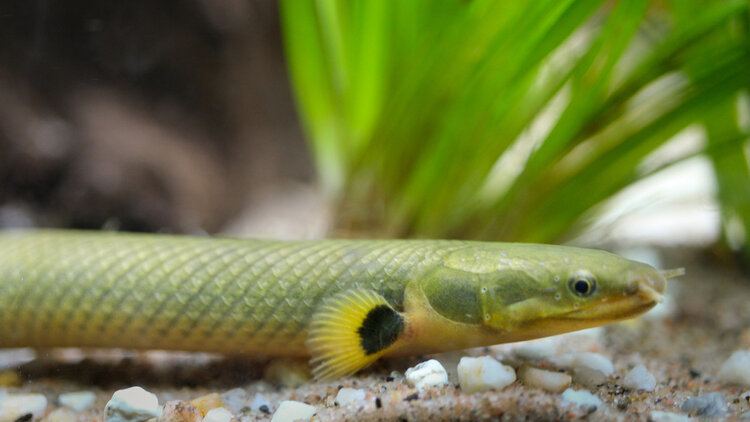
The reedfish is also known as the ropefish, and it is an eel-like fish species. They are fairly docile and peaceful, and for the most part, should not bother other fish. However, they are still eels, or in other words, they are predators, so anything that can easily fit in their mouths will be hunted and eaten during the night when it is feeding time.
Yet, these eels do great with other reedfish eels and should be kept in pairs or groups of three. They like to socialize with each other. A single reedfish requires an aquarium of 55 gallons, and three together should have a tank of about 180 gallons. The reedfish can grow to 18 inches or about 45 cm in length. The reedfish does on occasion burrow itself in the substrate, so fine gravel or sand is recommended, plus they like to have a fair amount of vegetation, rocks, caves, and other hiding places, but not quite as much as some other eel species.
These eels come from waters that are usually quite murky and muddy, with low levels of dissolved oxygen, so they have developed lung-like breathing apparatus and will often get air from the surface, although they do have gills to breathe underwater.
In terms of water temperature, it should be between 73 and 82 degrees Fahrenheit, with a pH level between 6 and 7.5, and a water hardness level between 2 and 15 dGH.
10. Kuhli Loach
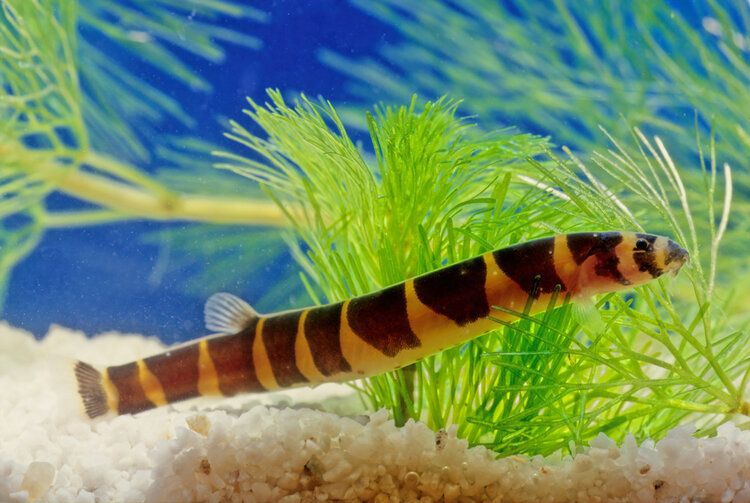
The smallest freshwater eel that you could have in a home aquarium is known as the Kuhli loach. These guys grow to only 4 inches or about 10 cm in length, making them great if you want an eel but don’t have a ton of space. However, these are schooling eels and enjoy being in groups of three or more, so for a group of six Kuhli loach eels, you will still need a tank of roughly 120 gallons to make sure that they are happy. When all is said and done, each individual Kuhli loach requires around 20 gallons of space.
They do not enjoy socializing with other fish, so keeping them in a community tank is not the best idea, although they will not bother other fish too much, they will most likely just keep hidden. Excessively small fish may get eaten by them, but because they are fairly small, this is usually not much of a problem.
When it comes down to it, it is other fish, especially larger and more aggressive fish, that can pose a threat to the Kuhli loach eel.
These eels love to burrow in the soft sand substrate and they really need a whole lot of vegetation, rocks, caves, driftwood, and other such hiding spaces. These are fairly easy to care for eels. They require the water temperature to be between 76 and 86 degrees Fahrenheit, with a pH level between 5.5 and 6.5, with a water hardness level between 5 and 10 dGH.
 How Long Do Freshwater Eels Live?
How Long Do Freshwater Eels Live?
How long a freshwater eel lives really depends on the species. There are some eels that live for 5 years, some for 10, some for up to 20 years, and there are some rarer and larger types that can go on to live for up to 60 years.
However, most that you can care for in a home aquarium are going to max out at about 20 years of age. That said, they do all live for quite some time and definitely qualify as a pretty large commitment.
Do Freshwater Eels Bite Humans?
Freshwater eels tend to be pretty skittish and scared of people, especially in the beginning when you first bring them home. However, after a couple of months, most will become used to you, and some can even be fed by hand as there are some which can recognize their owners. With that being said, there are some more aggressive eels that can and may bite humans.
The larger eels are not ones where you just want to stick your hand in the tank and go to pet it. Most of them have large and very powerful jaws with sharp teeth, and many of them can do some serious damage to your fingers.
The most dangerous one, due to obvious reasons, is the electric eel, which once again is definitely not recommended for anybody to keep at home.
Feeding Freshwater Aquarium Eels
Eels are carnivores for the most part and while they may eat plant matter on occasion, they usually eat fish, small crustaceans, and insects.
To feed your eels, a manner of live foods is recommended, including small feeder fish, brine shrimp, daphnia, insects, and insect larvae, as well as other small fish and crustaceans.
Freshwater Eel Tank Mates
When it comes to tank mates for your freshwater eels, perhaps the most important consideration to keep in mind is that eels are big and aggressive. If eels of this nature are kept with small, slow-swimming, and peaceful fish, the eels will bully them or worse. Eels will pick on smaller and weaker fish, and many eels will even eat smaller fish too, so anything small and peaceful is completely out of the question to keep with a freshwater eel.
Eels for the most part tend to stick to the bottom and the bottom-middle of the water column, which means that many fish which prefer the top of the water, the top of the column, might be compatible. That being said, even fish who prefer to reside in the top layers of the water still need to be able to fend for themselves when kept with freshwater eels.
Any fish you keep with freshwater eels need to be fairly large, tough, aggressive, and fairly quick too. Some of the best tank mates for freshwater eels include;
- Lionfish
- Tangs
- Triggerfish
- Wrasses
- Other large and aggressive fish
If you have a species of eel that is not very large or aggressive, the best tank mates may be other fish that are also non-aggressive.
 FAQs
FAQs
What size tank do Eels need?
This is a very general question that many people ask, a question that doesn’t have one general answer. The reason for this is that there are many species of freshwater fish tank eels out there, and they all grow to different sizes.
There are lots of species, so we won’t list individual ones, but what can be said is that an eel of 15 inches in length requires about 10 gallons of water, whereas a larger eel of 25 inches in length will need a tank of up to 20 gallons.
Simply put, you need to research the specific species of eel you have.
How big do freshwater eels grow?
Once again, this is a very general question with a not-so-general answer, and once again, this is because there are many freshwater eel species out there.
Tire track eels can grow to 30 inches in length, Zig Zag eels can grow to 35 inches long, Black Spotted eels can grow to 20 inches, Electric eels can grow to a full 5 feet long, peacock eels can grow to 12 inches in length, and half banded spiny eels only grow to a few inches in length.
Can eels survive out of water?
There are a select few types of eels that can live on land for an extended period, such as the European eel and the American eel.
If the soil is moist, these can even crawl overland short distances. However, eels are water creatures and none will survive out of water for more than a couple of hours.
Can eels hurt you?
Yes, eels have pretty big mouths and many have extremely sharp teeth. Eels can seriously injure you, so never just stick your hand in the tank.
Of course, this does once again depend on the specific type of eel. Let’s not forget that there are electric eels out there that can produce voltage high enough to stop a grown person’s heart.
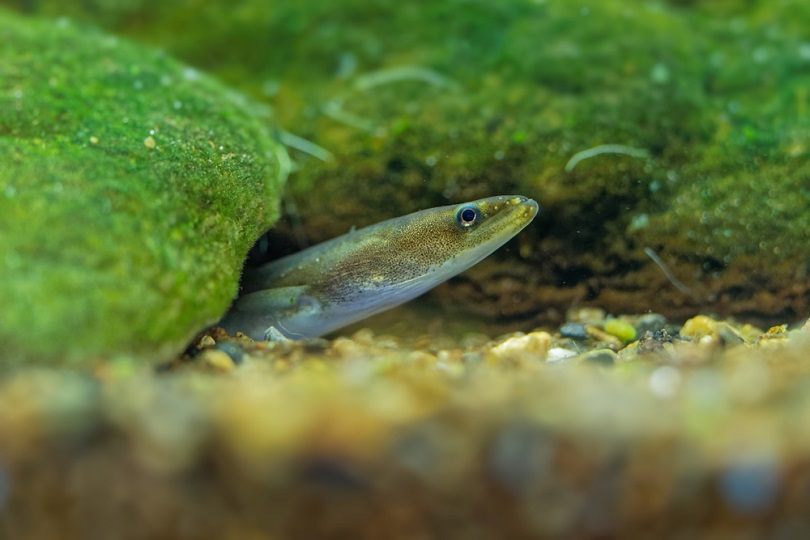
Conclusion
The bottom line is that eels are definitely some neat pets to have in your home, but they are definitely a step up from your average aquarium fish.
There are some smaller and more peaceful ones that are pretty simple to care for, but many of them get very big, require lots of space, are aggressive and hard to keep with companions, and care can be quite expensive too.
Feature Image Credit: Roberto Dani, Shutterstock

 How Long Do Freshwater Eels Live?
How Long Do Freshwater Eels Live?
